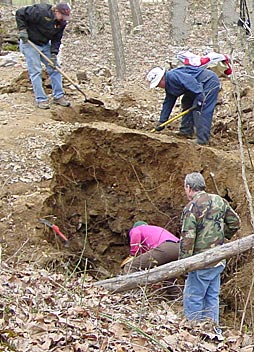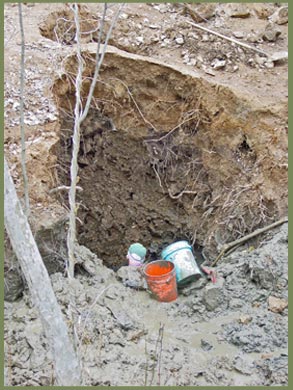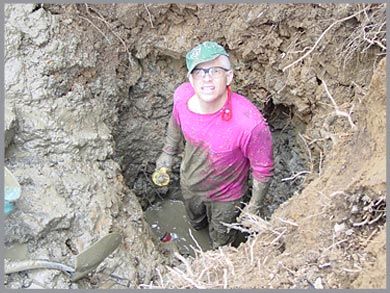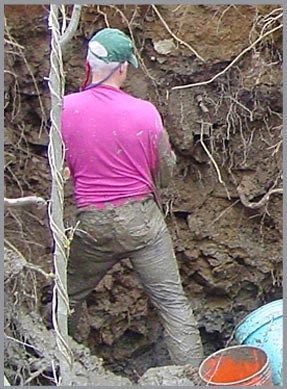After we took the museum tour and made some purchases in the gift shop, Mr. Frazer led us back out to where we had been Friday and turned us loose. Our plan for the day was to mostly surface collect

so that we could get better feel for the area in general in order to better direct the McRocks group in May. We headed out in various directions to scratch around. After about 45 minutes of wandering around and beating on an occasional boulder, I couldn't resist going over to check out the pit, even though I knew what I would find when I got there. Yep, I was right - still a nasty caldron of muck, so there really wasn't any reason to get back down into
that mess. But, what the heck was I going to do? It was mid-morning and I was itching to do some digging, but where????? How about I try digging a hole away from the creek - a fresh hole where I wouldn't have to contend with the creek, the mud and leaf litter? I turned on my rockhounding radar, picked a likely(?) spot and started digging down and down and down . . . After a while, Jeff, Don and James saw that I was digging a hole and came over to help out. I say help out, but to what end I couldn't promise because I pretty much just started
digging for digging sake, not knowing what else to do. Bill, who decided to take off the night before to visit his Mom near Knoxville, appeared to be the smart one, as we all dug and dug and dug. James followed suit and left Saturday morning around 11:00 AM.
By around noon, we had managed to reach the groundwater table in layer of tight gray clay and rocks - yippee, more water and mud.
 By then, I had started to find a few rocks that appeared to contain fluorite, but it was hard to tell if they were any good since they were mostly encrusted with thick gray mud. These were put aside for later cleaning and cobbing. As I continued to dig down, I created a hole that was about 5-feet long by 3-feet wide. I was able to use a bucket to evacuate the groundwater and mud that accumulated in the bottom of the hole since it was not connected to the creek and the groundwater infiltration was relatively slow due to the tight clay. My goal as the day before, was to reach the bedrock surface where Mr. Frazer claimed a horizontal vein/layer of fluorite existed.
By then, I had started to find a few rocks that appeared to contain fluorite, but it was hard to tell if they were any good since they were mostly encrusted with thick gray mud. These were put aside for later cleaning and cobbing. As I continued to dig down, I created a hole that was about 5-feet long by 3-feet wide. I was able to use a bucket to evacuate the groundwater and mud that accumulated in the bottom of the hole since it was not connected to the creek and the groundwater infiltration was relatively slow due to the tight clay. My goal as the day before, was to reach the bedrock surface where Mr. Frazer claimed a horizontal vein/layer of fluorite existed.
Jeff and Don had to hit the road around 1:00 PM, leaving Chrissy and me to keep working the hole and what I dragged out of it. I continued to dig for several more hours and finally hit the top of bedrock about 5' below the groundwater
table. I tested the top of rock and decided that it was essentially impenetrable by hand. But, while I was digging down to rock, I had discovered a great many rocks and boulders that contained what appeared to be excellent fluorite cubes. Again, it was difficult to tell if they were any good because of the mud and all were aside for later cobbing. While digging down to rock, I had recovered a few smallish fluorite specimens that I knew were worthy because Chrissy took them to the creek and washed them off with a toothbrush to show me before I finally abandoned my hole.


Muddy, wet and tired, I took the time in a chill wind to cob the rocks and boulders that had been set aside. We were pleased with much of what we saw and were cautiously optimistic that we'd have a decent pile of specimens to show for all our work once we had a chance to properly clean everything at home. We packed up the rocks, changed into clean dry clothes and headed back to our campground where we'd spend our final night before heading home the next morning.
As it turned out - we were all very happy with the lot. The following pictures are examples of some of the better specimens that were recovered.
Click on each specimen picture to enlarge
Click on each specimen picture to enlarge
Click on each specimen picture to enlarge
Click on each specimen picture to enlarge
The results of our reconnaissance trip indicate that the area is suitable for rockhounds of every level, from beginner to advanced and from intelligent to too-dumb-to-quit. We highly recommend attending at least one field trip there and the Ben E. Clement mineral museum is a once-in-a-lifetime must-see for all discerning rockhounds.
CLICK THE LITTLE MINER TO RETURN TO THE FIELD TRIP PAGE
